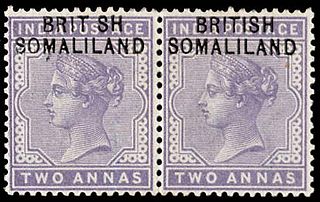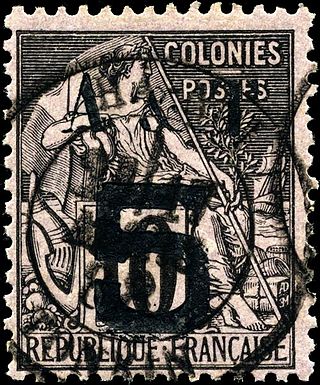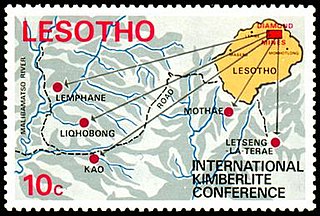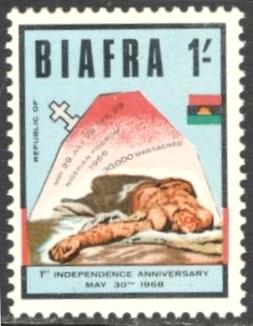Northern and Southern Cameroons
After French Cameroun became independent in January 1960, it was decided to hold plebiscites in Northern and Southern Cameroons in February 1961. Northern Cameroons opted to join Nigeria, effective from 31 May 1961, and so continued to use Nigerian stamps as before. Southern Cameroons opted to join Cameroon effective 1 October 1961.
In the interval, stamps of Nigeria values one halfpenny to one pound, overprinted CAMEROONS U.K.T.T. (United Kingdom Trust Territory) [3] were issued. These stamps were valid in Northern and Southern Cameroons until separate existence ended.
Shilling stamp used at
Mubi, now in Nigeria
Threepence stamp used at Kumba, now in Cameroon

British Cameroon or the British Cameroons was a British mandate territory in British West Africa, formed of the Northern Cameroons and Southern Cameroons. Today, the Northern Cameroons forms parts of the Borno, Adamawa and Taraba states of Nigeria, while the Southern Cameroons forms part of the Northwest and Southwest regions of Cameroon.

The French post offices in the Ottoman Empire were post offices in various cities of the Ottoman Empire run by France between 1812 and 1923. France was one of a half-dozen European countries, the others being Austria, Russia, Great Britain, Germany and Italy, which had been granted the right to maintain post offices within the Empire. This privilege was distinct from the so-called "Capitulations" which, since the 16th century, had been negotiated with a much larger number of countries and which granted some extraterritorial rights to citizens and commercial enterprises of those countries. Initially restricted to consular mail, these post offices could soon be used by foreign and local businesses and individuals, provided they used the postage stamps of the post office concerned. The system came to end with the Treaty of Lausanne in 1923.
This is a survey of the postage stamps and postal history of British East Africa.

Originally mail from British Somaliland used postage stamps of Egypt, then India. In 1903, about 30 types of stamps of India were overprinted "BRITISH / SOMALILAND".

The French post offices in Zanzibar were post offices operated by France in Zanzibar from January 16 1889 to July 31 1904, when the United Kingdom took direct control of what had previously been a protectorate.
This is a survey of the postage stamps and postal history of the Niger Coast Protectorate.

This is a survey of the postal history and postage stamps of French Polynesia, formerly known as the French Oceania.

A concise postal history of French Annam protectorate and Tongking protectorate, former territories of colonial French Indochina, that were located in present-day Vietnam. Dates 1888 - 1892
Each "article" in this category is a collection of entries about several stamp issuers, presented in alphabetical order. The entries are formulated on the micro model and so provide summary information about all known issuers.

This is a survey of the postage stamps and postal history of Chad.

The British post offices in Africa were a system of post offices set up by the United Kingdom to be used by its Middle East Forces and East Africa Forces in Africa during and after World War II.

Batumi is a city on the Black Sea coast and capital of Adjara, an autonomous republic in southwest Georgia. The city was under Russian rule at the beginning of World War I, but local unrest led to Turkey entering the city in April 1918, followed by the British in December, who stayed until July 1920.

The postage stamps and postal history of Armenia describes the history of postage stamps and postal systems in Armenia. Czarist Russian postmarks and stamps were in used in the territory of Armenia from 1858. The early postmarks were composed of dots in different shapes. Dated postmarks with city names soon followed. Many counterfeit postmarks are known. From 1909 until 1918 a few Russian stamps were overprinted identifying the Armenian Post. The Armenian letters H & P are intertwined, representing the initials of hai post, the Armenian Post Office.

Postage stamps have been used in Cameroon or Cameroun since the nineteenth century.
Qatar was a British protectorate from 1916 till it gained independence on 3 September 1971. Until 1950, the country's postal service was administered by an Indian post office in Bahrain. A British office was opened in Doha and sold stamps of British Postal Agencies in Eastern Arabia until 1957 when overprinted British stamps were introduced. Qatar Post took responsibility for postal administration in May 1963 and joined the Universal Postal Union in January 1969. The first Qatari stamps were issued in 1961 and there was an independence issue in January 1972. Since then, Qatar Post has continued to manage the country's postal administration and to issue its stamps, which are mostly relevant to Qatar itself.

This is a survey of the postage stamps and postal history of Libya. Libya is a country located in North Africa. Bordering the Mediterranean Sea to the north, Libya lies between Egypt to the east, Sudan to the southeast, Chad and Niger to the south, and Algeria and Tunisia to the west.

This is a survey of the postage stamps and postal history of Lesotho, formerly known as Basutoland.
This is a survey of the postage stamps and postal history of Nigeria.

This is a survey of the postage stamps and postal history of Biafra.

British postal agencies in Eastern Arabia issued early postage stamps used in each of Abu Dhabi, Bahrain, Dubai, Kuwait, Muscat and Qatar. Muscat and Dubai relied on Indian postal administration until 1 April 1948 when, following the Partition of India, British agencies were established there. Two agencies were opened in Qatar: at Doha and Umm Said. In Abu Dhabi, an agency was opened on Das Island in December 1960 and in Abu Dhabi City on 30 March 1963. The agencies also supplied stamps to Bahrain until 1960; and to Kuwait during shortages in 1951–53.
This page is based on this
Wikipedia article Text is available under the
CC BY-SA 4.0 license; additional terms may apply.
Images, videos and audio are available under their respective licenses.


















